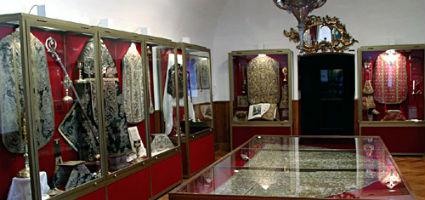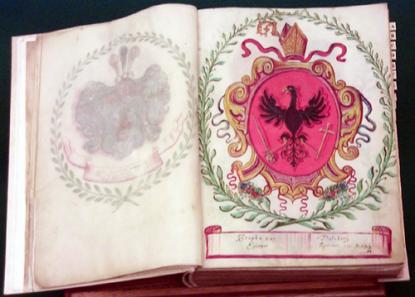2025. July 16. Wednesday
Archbishopric Collection Center - Eger
 |
Address: 3300, Eger Széchenyi utca 5.
Phone number: (36) 421-332
E-mail: erzsiloeffler@hotmail.com
Opening hours: 01.04-30.10.: Tue-Sat 9-17
01.11-31.03.: Mon-Fri 8-16 |
The king Saint Stephen founded the diocese of Eger. We do not know the exact date, but we are positive that it existed in 1009 under the protection of the apostle Saint John and the evangelist John. The old center stood where the castle stands today, near Saint John Abbey. The oldest ecclesiastic building found there was built around the turn of the 10-11th centuries. It is probable that the third bishop of Eger, Buldus, who died when Saint Gellért did, was buried there.
The diocese of Eger had 14 regions belonging to it in the 14th century. It is probable that the first cathedral was built right after the church was established. The heydays of the episcopate were in the 15th century. The gothic bishop palace was built around then and the cathedral was extended. After the fast development of the 15th century, anarchy and the unresolved defense of the country after the loss of battle at Mohács, the episcopate began to decline. The castle was owned by many of the followers of Szapolyai János and Ferdinand Habsburg, thus among others Perényi Péter and Varcoch Tamás. The arrival of Reformation at Eger and the organization of the Lutheran ecclesia was also around that time.
In 1548, the bishop of Eger was Oláh Miklós who realized the importance of the defense of the castle. He made a compact with a king according to which the income of the episcopate was divided into three parts. One third was spent on building a fortification, one third on having an army and one third was kept by the episcopate. From 1548, the captain of the castle was Dobó István. With this, the rule of the protestants ceased but the income had to be sent on the castle still.
After Dobó, the captains of the castle were the Protestants Bornemissza Gergely, Figedy János and Zárkándy Pál. Until 1448, the order operated without difficulties. In the same year, the bishop was Verancsics Antal who had a stronger personality than his predecessor did.
The new head captian, Magócsy Gáspár, spurred Protestantism. In 1566, he rebuilt the abbey and forbade every Catholic to enter the territory of the castle.
In 1572, Radéczy István was the bishop of Eger. When he saw the mournful state of the abbey, he appointed the Saint Michael church to operate as an abbey in 1580 and bestowed it to the prebend for good. Until the Turkish seized the town of Eger, Calvinism was the determining religion.
It was the center for the next 91 years and Catholicism ceased to exist in town. However, the seat of the bishop was continuously occupied during the reign since the bishop played a very important part in the politics of life.
The diocese of Eger had 14 regions belonging to it in the 14th century. It is probable that the first cathedral was built right after the church was established. The heydays of the episcopate were in the 15th century. The gothic bishop palace was built around then and the cathedral was extended. After the fast development of the 15th century, anarchy and the unresolved defense of the country after the loss of battle at Mohács, the episcopate began to decline. The castle was owned by many of the followers of Szapolyai János and Ferdinand Habsburg, thus among others Perényi Péter and Varcoch Tamás. The arrival of Reformation at Eger and the organization of the Lutheran ecclesia was also around that time.
In 1548, the bishop of Eger was Oláh Miklós who realized the importance of the defense of the castle. He made a compact with a king according to which the income of the episcopate was divided into three parts. One third was spent on building a fortification, one third on having an army and one third was kept by the episcopate. From 1548, the captain of the castle was Dobó István. With this, the rule of the protestants ceased but the income had to be sent on the castle still.
After Dobó, the captains of the castle were the Protestants Bornemissza Gergely, Figedy János and Zárkándy Pál. Until 1448, the order operated without difficulties. In the same year, the bishop was Verancsics Antal who had a stronger personality than his predecessor did.
The new head captian, Magócsy Gáspár, spurred Protestantism. In 1566, he rebuilt the abbey and forbade every Catholic to enter the territory of the castle.
In 1572, Radéczy István was the bishop of Eger. When he saw the mournful state of the abbey, he appointed the Saint Michael church to operate as an abbey in 1580 and bestowed it to the prebend for good. Until the Turkish seized the town of Eger, Calvinism was the determining religion.
It was the center for the next 91 years and Catholicism ceased to exist in town. However, the seat of the bishop was continuously occupied during the reign since the bishop played a very important part in the politics of life.
